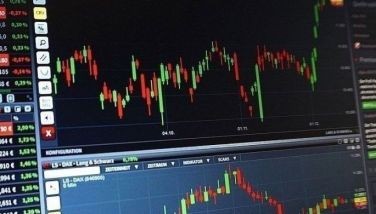Let it go

Last week, I conducted a talk for a Xavier School charity event. I discussed my investment philosophy and Philequity’s strategy for riding the ongoing bull market in stocks. I also explained how this bull market started and why it has become the longest and strongest bull run in our stock market’s history. Below is a brief summary of my talk.
In order to appreciate how the current bull market came about, one has to understand the devastating financial landscape in 2008. In fact, “Doom and gloom” is the title of the first chapter of our book, “Opportunity of a Lifetime.” In that chapter, we recollected how Lehman collapsed, while other major financial institutions such as AIG, Bear Sterns and Merrill Lynch teetered on the brink of bankruptcy. Credit markets froze, the economy was in a recession and stock markets were in a free fall. It was the worst bear market in history, similar in scale and magnitude to the Great Depression in 1929.
The central bankers had to step in to prevent a financial armageddon from ensuing. The rescue of the central banks was spearheaded by former Fed chairman Bernanke. Under his lead, the Fed pulled all the stops by fully utilizing its monetary toolkit and resorting to unconventional policy tools when needed. The Fed’s determined actions provided a lifeline to the banking sector and revived credit markets.
Bernanke’s resolve and the Fed’s decisive actions kept the financial system alive and restored confidence in the stock market. This led to the conclusion of the savage bear market of 2008-2009, which ended when the S&P 500 hit an intraday low of 666 on March 6, 2009 (666 on 3-6-9, April 13, 2009). The current bull market was born as the Fed’s policies stimulated a revival in bank lending and a slow but gradual economic recovery.
The great global monetary easing
Bernanke’s lead was soon followed by other countries such as Europe and Japan (The Great Global Monetary Easing, Oct. 22, 2012). European Central Bank (ECB) president Mario Draghi famously said he would do “whatever it takes” to save the euro and revive the European economy (Whatever it takes, Aug. 27, 2012). Meanwhile, Bank of Japan (BOJ) Governor Haruhiko Kuroda pledged to pitch the Japanese economy out of a 23-year sandtrap (Out of the sandtrap, April 15, 2013). The great global monetary easing ensued as central banks around the world undertook their own stimulus programs to revive their respective economies.
Central banks around the world brought down interest rates to historic lows to sustain the reflation. In fact, many countries experienced zero or negative interest rates. The low interest rate environment has left investors with no choice but to buy stocks and long-term bonds. This has been the main driving force behind the first phase of the current bull market.
While the first part of the bull market was fuelled by historically low interest rates, the next phase is driven by global economic growth. The coordinated stimulus programs implemented by the Fed and other major central banks gave rise to the synchronized and broad-based economic growth we are currently witnessing. The economic recovery that started in the US soon made its way to Europe, Japan, China and emerging markets such as the Philippines (Synchronized global growth, June 13, 2017). This is supported by a pick-up in manufacturing activity and global trade.
Stronger global economic growth has bolstered the growth of corporate earnings. Corporates continue to thrive in this environment as fundamentals have remained strong. For 2018, both the US and the Philippines are expected to deliver double-digit corporate earnings growth.
Synchronized global economic growth and rising corporate earnings have led to a global bull market. Stock markets around the globe have performed impressively this year, with most indices trading at all-time or multi-year highs. The global bull run has driven the stellar performance of the PSEi this year.
Though the current bull market is eight years and eight months old, it has shown no signs it will stop anytime soon. Based on last Friday’s close of 8,433, the PSEi is up 400 percent from its bear market bottom. It is, therefore, clear we are in the middle of the longest and strongest bull run in our stock market’s history.
The PSEi has gone up sharply after staging a decisive breakout past the 8,000-level. It is, therefore, possible for our market to experience corrections or pullbacks. One should not fear corrections as these are normal occurrences in a bull market. It is important to remember the long-term uptrend for stocks is intact, underpinned by broad-based global economic growth, low interest rates, rising corporate earnings and a global equities bull run.
Let it go
Understanding how this bull market came about and why it has remained very strong should give one the requisite confidence to stay invested in stocks despite setbacks, risks and corrections. Thus, our advice remains the same: stay the course, ride the uptrend and continue letting the bull run go.
We would like to end our article with an excerpt from “Let it go”, the theme song of the movie Frozen.
It’s funny how some distance
Makes everything seem small
And the fears that once controlled me
Can’t get to me at all
It’s time to see what I can do
To test the limits and break through
No right, no wrong, no rules for me,
I’m free!
Let it go, let it go
I am one with the wind and sky
Let it go, let it go
You’ll never see me cry
Here I stand
And here I’ll stay
Let the storm rage on…
…the cold never bothered me anyway
Philequity Management is the fund manager of the leading mutual funds in the Philippines. Visit www.philequity.net to learn more about Philequity’s managed funds or to view previous articles. For inquiries or to send feedback, please call (02) 689-8080 or email [email protected].
- Latest
- Trending




























